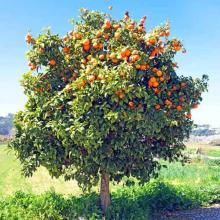Citrus x aurantium
Common name:
Sweet orange
Genus:
Citrus
Family:
Rutaceae
Order:
Sapindales
Citrus x aurantium
Common name:
Sweet orange
Genus:
Citrus
Family:
Rutaceae
Order:
Sapindales
Citrus x aurantium
Common name:
Sweet orange
Genus:
Citrus
Family:
Rutaceae
Order:
Sapindales
Genus (Plantae): Citrus
Citrus is a genus of flowering trees and shrubs in the rue family, Rutaceae. Plants in the genus produce citrus fruits, including important crops such as oranges, lemons, grapefruits, pomelos, and limes. The genus Citrus is native to South Asia, East Asia, Southeast Asia, Melanesia, and Australia. Various citrus species have been utilized and domesticated by indigenous cultures in these areas since ancient times. From there its cultivation spread into Micronesia and Polynesia by the Austronesian expansion (c. 3000–1500 BCE); and to the Middle East and the Mediterranean (c. 1200 BCE) via the incense trade route, and onwards to Europe.
Description
Tree
These plants are large shrubs or small to moderate-sized trees, reaching 5–15 m (16–49 ft) tall, with spiny shoots and alternately arranged evergreen leaves with an entire margin. The flowers are solitary or in small corymbs, each flower 2–4 cm (0.79–1.57 in) diameter, with five (rarely four) white petals and numerous stamens; they are often very strongly scented, due to the presence of essential oil glands.
Fruit
The fruit is a hesperidium, a specialized berry, globose to elongated, 4–30 cm (1.6–11.8 in) long and 4–20 cm (1.6–7.9 in) diameter, with a leathery rind or "peel" called a pericarp. The outermost layer of the pericarp is an "exocarp" called the flavedo, commonly referred to as the zest. The middle layer of the pericarp is the mesocarp, which in citrus fruits consists of the white, spongy "albedo", or "pith". The innermost layer of the pericarp is the endocarp. The space inside each segment is a locule filled with juice vesicles, or "pulp". From the endocarp, string-like "hairs" extend into the locules, which provide nourishment to the fruit as it develops. Many citrus cultivars have been developed to be seedless (see nucellar embryony and parthenocarpy) and easy to peel.
Citrus fruits are notable for their fragrance, partly due to flavonoids and limonoids (which in turn are terpenes) contained in the rind, and most are juice-laden. The juice contains a high quantity of citric acid and other organic acids giving them their characteristic sharp flavor. The genus is commercially important as many species are cultivated for their fruit, which is eaten fresh, pressed for juice, or preserved in marmalades and pickles.
They are also good sources of vitamin C. The content of vitamin C in the fruit depends on the species, variety, and mode of cultivation. The flavonoids include various flavanones and flavones.
Reference: Wikipedia

